History of Cusco facts for kids
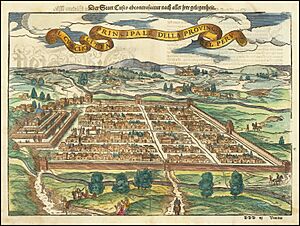
The history of Cusco in Peru is super interesting! This city was once the amazing capital of the Incas, a powerful ancient empire. Let's explore how Cusco grew from a small settlement into a grand city.
Contents
How Cusco Began: The Inca Story
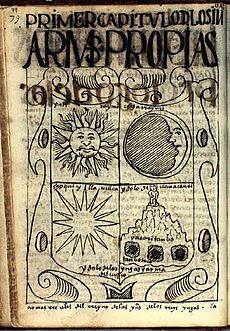
Long ago, the Incas had a special story about how Cusco started. It's a legend told by the writer Inca Garcilaso de la Vega. He wrote that Manco Cápac and Mama Ocllo, who were like the first Incas, came from Lake Titicaca. Their father, the Sun god, told them to find a new home.
They carried a golden stick. Wherever it sank easily into the ground, that would be their new city. The legend says they found this perfect spot in a valley, and that's where Cusco was founded.
The Real Start of Cusco
Even though the legend is cool, scientists and historians have found a different story through old remains and studies. They believe that people moved to the Huatanay River Valley after another kingdom, Tiwanaku, fell apart. About 500 people slowly settled there. This led to the founding of Cusco, right by the Saphy River. We don't know the exact date, but people lived in this area at least 3000 years ago!
Before the Incas became super powerful, other groups lived in the Cusco valley. Writers like Pedro Sarmiento de Gamboa mentioned groups like the Guallas and Sahuasiray. The Ayarmacas were also there and were strong rivals to the Incas for control of the region.
Cusco: The Heart of the Inca Empire
Cusco became the capital and main city of the Inca Kingdom. When the empire grew, Cusco remained its most important city. It was the center of culture and religion for the entire Andes region and even South America.
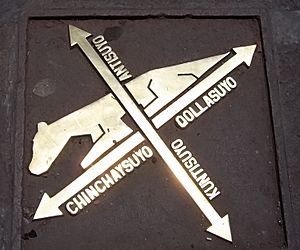
A great Inca ruler named Pachacuti is often given credit for making Cusco such a spiritual and political hub. Pachacuti became ruler in 1438. He and his son, Túpac Yupanqui, spent 50 years bringing different groups together under Inca rule. Their empire stretched from Quito in the north to the Maule River in the south. This brought many different cultures together over 4500 km of mountains!
It's also thought that Pachacuti designed the city of Cusco itself. The old map of Cusco looks like a cougar! The main square, Haucaypata (where the Plaza de Armas is today), was like the cougar's chest. The head of the cougar was on the hill where the amazing fortress of Sacsayhuamán stands.
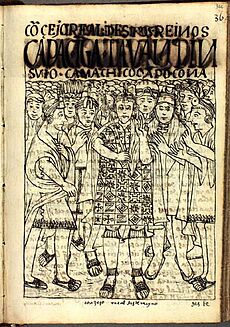
Cusco was built as the center of power. It was located at a key point in the empire. Four main roads led out from Cusco, connecting it to all four parts of the Inca Empire, called the suyos.
Cusco Under Spanish Rule
The Spanish Arrive in Cusco
When the Spanish conquistadors arrived in what is now Peru, they knew their main goal was to capture Cusco. It was the capital of the Inca Empire.
After the Inca ruler Atahualpa died, the Spanish leader Francisco Pizarro and his men marched towards Cusco. This was in August 1533. They were joined by Manco Cápac, a young Inca prince. Manco Cápac wanted to help the Spanish remove the troops of Quizquiz, an Inca general loyal to Atahualpa. So, Manco Cápac gathered many people from Cusco, plus other groups like the Cañaris, to help the Spanish.
In November 1533, Quizquiz's troops left the city. The Spanish and their allies chased them and defeated them in a battle.
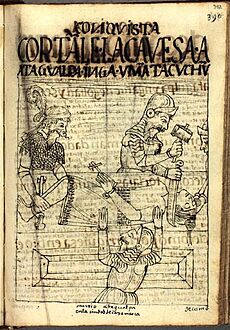
On November 15, 1533, Francisco Pizarro took control of Cusco. At first, the people of Cusco were happy that Atahualpa's forces were gone. But soon, they became unhappy. The Spanish took many treasures from Inca monuments and sacred places. They found huge amounts of gold and silver. They even took jewels from royal mummies and found golden statues of women and llamas!
At Christmas, Manco Inca (the young prince) accepted the Spanish king's authority. He also sent his army of about 10,000 soldiers to help the Spanish explore other areas.
The Siege of Cusco
While Cusco was under the control of Francisco Pizarro's brothers, Manco Inca planned to escape. He wanted to gather a new army. His first attempt failed, but on April 18, 1536, he successfully escaped to Yucay. There, he gathered a huge army of about 100,000 men. On May 3, 1536, he began to attack Cusco. He also sent another army to Lima.
Inside Cusco, only about 200 Spanish soldiers, led by Pizarro's brothers, and about 1,000 Cañari and Chachas allies were trapped. They were in a very difficult situation. On May 14, there was a fierce battle for the fortress of Sacsayhuamán. An Inca captain named Cullash (also known as Cahuide) bravely jumped from the top of a tower during this fight. Manco Inca tried four times to capture Cusco. The last attempt was in August 1536. He had to stop because it was time for his soldiers to go back to their farms and plant crops. If they didn't, there would be no food.
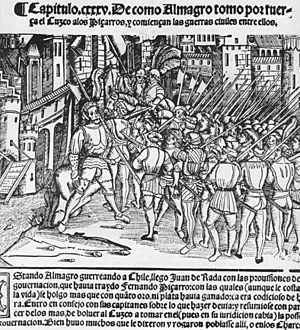
Later, in September, Manco Inca's main general, Tiso Yupanqui, won several battles against the Spanish. One important battle was near Ollantaytambo in January 1537.
After a failed trip to Chile, Diego de Almagro returned to Cusco on May 8, 1537. He took control and even imprisoned Francisco Pizarro's brothers for a few weeks. Then, he fought against Manco Inca and defeated him in Vitcos. Manco Inca then fled to Vilcabamba, where he was later killed in 1542 by some Spanish people he had given shelter to.
Troubles and Changes in Cusco
Diego de Almagro fought against Hernando Pizarro's troops and was defeated in the Battle of Las Salinas in April 1538. He was brought back to Cusco, imprisoned, and later died there in July 1538.
In 1540, the Spanish king gave Cusco the official title of "head of the Kingdoms of Peru" and "very noble, loyal, and very faithful great city of Cuzco."
There were more conflicts in the region. In 1542, Diego de Almagro II was captured and died in Cusco. In 1548, there was a rebellion led by Gonzalo Pizarro, who also died in the city. In 1572, the last Inca rebel, Túpac Amaru, was also executed in Cusco's main square. His death led to the famous myth of Inkarrí.
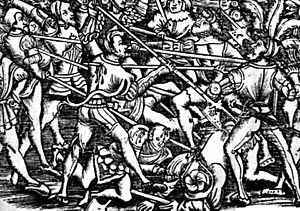
The first viceroy, Blasco Núñez Vela, arrived in 1544. He brought new laws that reduced the power of the Spanish settlers who controlled large areas and native workers (called encomenderos). These settlers didn't like the new laws. In Cusco, Gonzalo Pizarro rebelled against the viceroy and ruled Peru from 1544 to 1548. But the king of Spain sent a peacemaker, Pedro de la Gasca, who defeated Gonzalo Pizarro in 1548.
After these conflicts, Cusco became very important for trade and money in the Andes. It was a central point for major roads. Mining became very popular in the Andes, especially after the discovery of the Potosí mines (rich in silver) and the Huancavelica mercury mines. Cusco was a key link between these mining areas. This led to a boom in textile work, farming, and transportation in the Cusco region.
Cusco's Golden Age
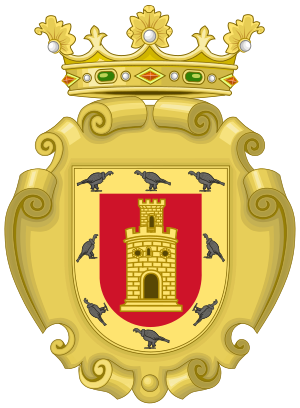
In 1560, a young writer named Inca Garcilaso de la Vega (who was part Inca, part Spanish) left Cusco for Spain. In 1609, he published his famous book, Comentarios Reales de los Incas, about Inca history and the Spanish conquest.
During this time, the Spanish government made changes to how native communities worked. They created special farming areas where native people produced food for themselves. They also made rules for landowners to give land and wages to native workers. Cusco was a main place where these new rules were put into practice.
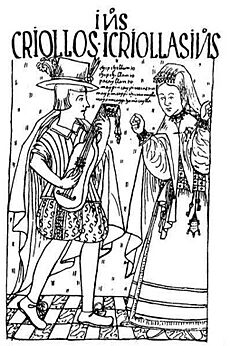
Cusco also grew as a center for learning. The Royal College Seminary of San Antonio el Magno was founded in 1598. The University of San Antonio Abad opened in 1696.
Hospitals were also built in Cusco starting in 1546. The Hospital de Nuestra Señora de la Piedad (later San Juan de Dios) and the Hospital de Naturales were important for the city.
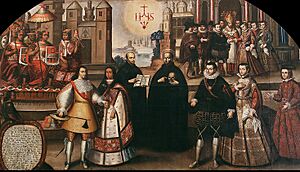
Some wealthy families in Cusco, including those with Inca noble roots, continued to hold special rights over land and taxes. This helped rich landowners grow their fortunes.

A huge earthquake hit Cusco on March 31, 1650. This event led to big plans to rebuild and improve the city. Bishop Manuel de Mollinedo y Angulo was a key person who supported many new art projects and buildings. He helped build churches like La Almudena, San Pedro, and San Sebastián. He also supported the famous Cusco School of painting, which included talented artists like Diego Quispe Tito.
Many important buildings were rebuilt after the earthquake. The Cusco Cathedral was finished in 1735. The convent of Santo Domingo, built on the Inca Inti temple of Coricancha, was also rebuilt. The Church of La Compañía de Jesús, one of the most beautiful in the Americas, was rebuilt too. The earthquake helped builders learn new techniques, making the new buildings strong and beautiful.
Cusco was the most important city in the viceroyalty of Peru until the late 1600s, when Lima became more prominent.
Sickness in Cusco
Cusco also faced many epidemics during the Spanish colonial period. Between April and November 1720, a terrible fever caused many deaths. About 40,000 people died in the surrounding areas, and 20,000 died in the city of Cusco itself. On some days, up to 700 people died in Cusco. No one knows exactly what disease it was, but old records mention a "malarial fever." A cemetery was built in a ravine, which was later called Ayahuayco, because of all the deaths.
Despite the sickness, Cusco remained a busy place. Mining in Potosí and Huancavelica meant many workers and goods passed through Cusco. One writer in 1773 described Cusco as "a very populated city, of great human movement and sustained transportation of goods."
Cusco and Independence
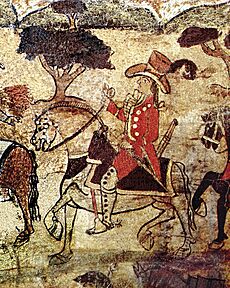
In 1780, the city of Cusco was shaken by a big movement led by the native leader José Gabriel Condorcanqui, known as Túpac Amaru II. He rose up against the Spanish rulers because of unfair taxes and harsh treatment of native workers. His uprising caused a lot of trouble for the Spanish. Túpac Amaru II was eventually defeated, captured, and died with most of his family in Cusco's Plaza de Armas. You can still see the chapel that served as his prison next to the Church of La Compañía de Jesús. This movement spread across the Andes and inspired others to fight for independence in South America.
After Túpac Amaru II's defeat, many Spanish noble families moved to Lima and Arequipa because they were worried about more native uprisings. Also, a new viceroyalty (like a large Spanish territory) was created, which reduced Cusco's importance as a trade hub. This led to a decline in the city's growth in the 1800s.
Fights for Freedom
Even after Túpac Amaru II's defeat, people in Cusco continued to dream of freedom. In 1805, leaders like Gabriel Aguilar and Manuel Ubalde secretly planned to weaken Spanish power. In 1813, the José and Vicente Angulo tried to start a rebellion in Cusco.
On August 3, 1814, they succeeded! They made the first declaration of independence from Spain in Cusco. They organized a military campaign with Brigadier Mateo Pumacahua as their leader. They had some success for several months, but the Spanish royal army eventually defeated them in the Battle of Umachiri in February 1815. On April 21, Pumacahua and other rebel leaders died in Cusco.
Before Peru gained its full independence, the region around Cusco was a large area called the Intendancy of Cuzco. It had many provinces and a population of over 216,000 people in 1796. This population stayed about the same until 1822, when Peru was preparing for its first national congress.
See also
- List of buildings and structures in Cusco
- Atahualpa, the last Inca king
|



